MAZDA MODEL MX-5 MIATA PRHT 2015 Owner's Guide
Manufacturer: MAZDA, Model Year: 2015, Model line: MODEL MX-5 MIATA PRHT, Model: MAZDA MODEL MX-5 MIATA PRHT 2015Pages: 448, PDF Size: 4.7 MB
Page 31 of 448

Black plate (31,1)
Passenger seat weight sensors
These sensors deactivate the passenger front and side air bags and also the passenger seat
belt pretensioner system when the passenger air bag deactivation indicator light
illuminates.
When an infant or small child is seated on the passenger seat, the system shuts off the
passenger air bag, so make sure the passenger air bag deactivation indicator light
illuminates.
Refer to Passenger Seat Weight Sensors on page 2-37.
WARNING
Use the correct size child-restraint system:For effective protection in vehicle accidents and sudden stops, a child must be
properly restrained using a seat belt or child-restraint system depending on age and
size. If not, the child could be seriously injured or even killed in an accident.
Follow the manufacturer's instructions and always keep the child-restraint system
buckled down: An unsecured child-restraint system is dangerous. In a sudden stop or a collision it
could move causing serious injury or death to the child or other occupants. Make
sure any child-restraint system is properly secured in place according to the child-
restraint system manufacturer's instructions. When not in use, remove it from the
vehicle or fasten it with a seat belt.
Always secure a child in a proper child-restraint system: Holding a child in your arms while the vehicle is moving is extremely dangerous. No
matter how strong the person may be, he or she cannot hold onto a child in a
sudden stop or collision and it could result in serious injury or death to the child or
other occupants. Even in a moderate accident, the child may be exposed to air bag
forces that could result in serious injury or death to the child, or the child may be
slammed into an adult, causing injury to both child and adult.
Always make sure the passenger air bag deactivation indicator light is illuminated
when using a child-restraint system: Seating a child in a child-restraint system that is installed on the passenger seat with
the passenger air bag deactivation indicator light not illuminated is extremely
dangerous. In an accident, an air bag could inflate and cause serious injuries or even
death to the child seated in the child-restraint system. Always make sure the
passenger air bag deactivation indicator light is illuminated.
Essential Safety Equipment
Child Restraint
2-19
MX-5_8EN7-EA-14E_Edition3 Page31
Friday, September 5 2014 3:19 PM
Form No.8EN7-EA-14E
Page 32 of 448
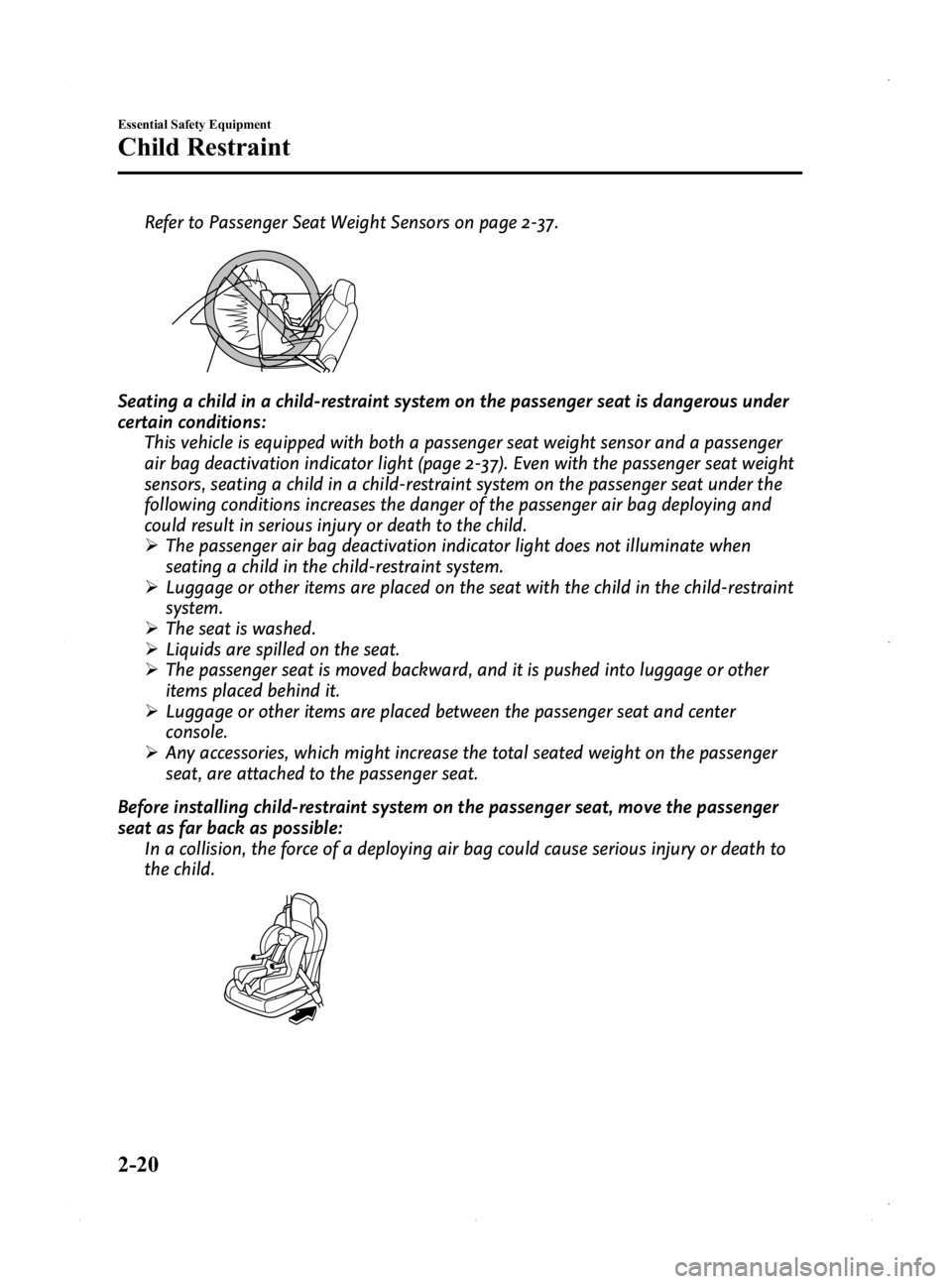
Black plate (32,1)
Refer to Passenger Seat Weight Sensors on page 2-37.
Seating a child in a child-restraint system on the passenger seat is dangerous under
certain conditions:This vehicle is equipped with both a passenger seat weight sensor and a passenger
air bag deactivation indicator light (page 2-37). Even with the passenger seat weight
sensors, seating a child in a child-restraint system on the passenger seat under the
following conditions increases the danger of the passenger air bag deploying and
could result in serious injury or death to the child.
ØThe passenger air bag deactivation indicator light does not illuminate when
seating a child in the child-restraint system.
Ø Luggage or other items are placed on the seat with the child in the child-restraint
system.
Ø The seat is washed.
Ø Liquids are spilled on the seat.
Ø The passenger seat is moved backward, and it is pushed into luggage or other
items placed behind it.
Ø Luggage or other items are placed between the passenger seat and center
console.
Ø Any accessories, which might increase the total seated weight on the passenger
seat, are attached to the passenger seat.
Before installing child-restraint system on the passenger seat, move the passenger
seat as far back as possible: In a collision, the force of a deploying air bag could cause serious injury or death to
the child.
2-20
Essential Safety Equipment
Child Restraint
MX-5_8EN7-EA-14E_Edition3 Page32
Friday, September 5 2014 3:19 PM
Form No.8EN7-EA-14E
Page 33 of 448
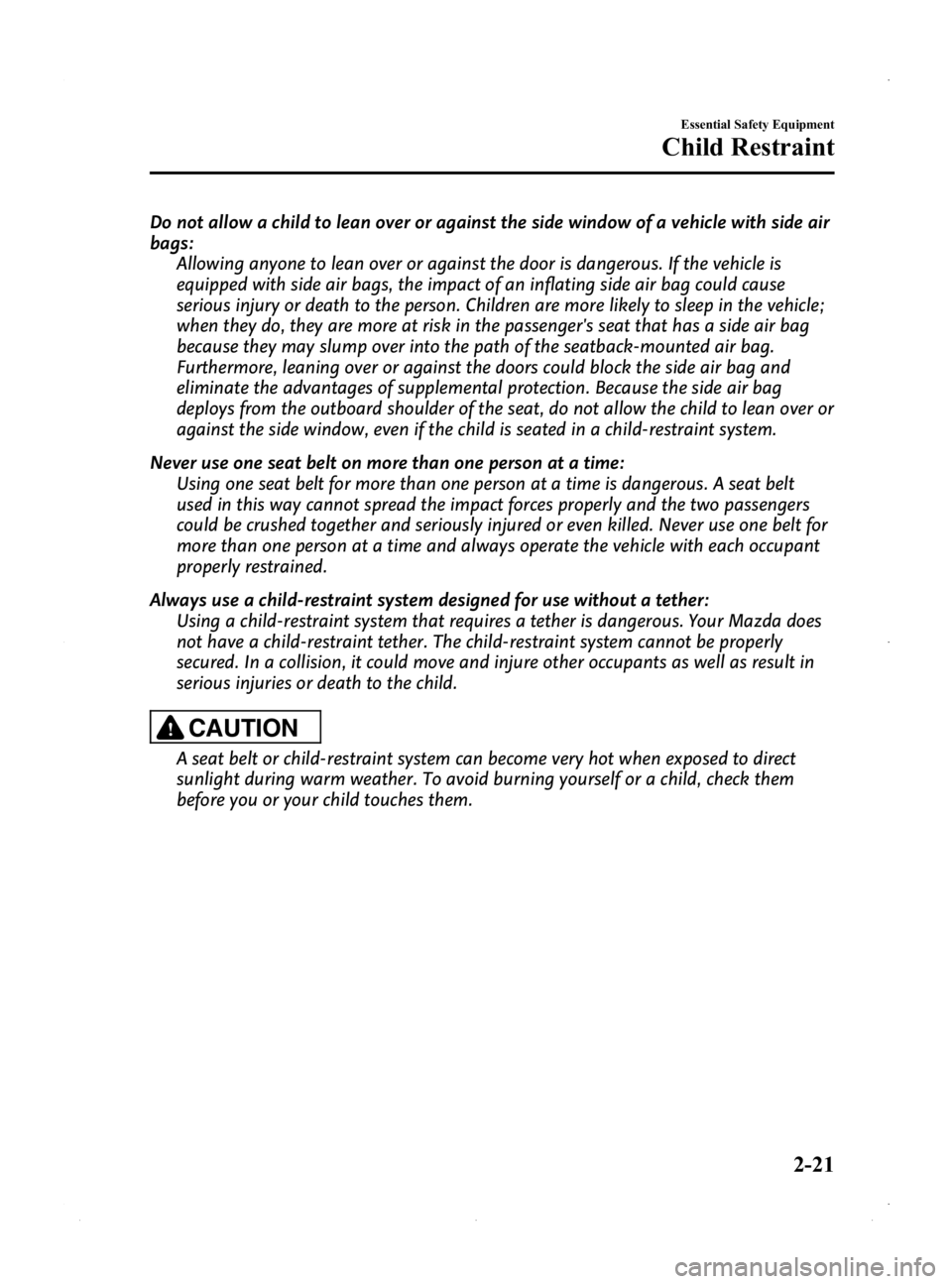
Black plate (33,1)
Do not allow a child to lean over or against the side window of a vehicle with side air
bags:Allowing anyone to lean over or against the door is dangerous. If the vehicle is
equipped with side air bags, the impact of an inflating side air bag could cause
serious injury or death to the person. Children are more likely to sleep in the vehicle;
when they do, they are more at risk in the passenger's seat that has a side air bag
because they may slump over into the path of the seatback-mounted air bag.
Furthermore, leaning over or against the doors could block the side air bag and
eliminate the advantages of supplemental protection. Because the side air bag
deploys from the outboard shoulder of the seat, do not allow the child to lean over or
against the side window, even if the child is seated in a child-restraint system.
Never use one seat belt on more than one person at a time: Using one seat belt for more than one person at a time is dangerous. A seat belt
used in this way cannot spread the impact forces properly and the two passengers
could be crushed together and seriously injured or even killed. Never use one belt for
more than one person at a time and always operate the vehicle with each occupant
properly restrained.
Always use a child-restraint system designed for use without a tether: Using a child-restraint system that requires a tether is dangerous. Your Mazda does
not have a child-restraint tether. The child-restraint system cannot be properly
secured. In a collision, it could move and injure other occupants as well as result in
serious injuries or death to the child.
CAUTION
A seat belt or child-restraint system can become very hot when exposed to direct
sunlight during warm weather. To avoid burning yourself or a child, check them
before you or your child touches them.
Essential Safety Equipment
Child Restraint
2-21
MX-5_8EN7-EA-14E_Edition3 Page33
Friday, September 5 2014 3:19 PM
Form No.8EN7-EA-14E
Page 34 of 448

Black plate (34,1)
Child-Restraint System
Installation Position
In this owner's manual, explanation of
child-restraint systems is provided for the
following three types of popular child-
restraint systems: infant seat, child seat,
booster seat.
NOTE
lInstallation position is determined by the
type of child-restraint system. Always read
the manufacturer's instructions and this
owner's manual carefully.
lDue to variations in the design of child-
restraint systems, vehicle seats and seat
belts, all child-restraint systems may not fit
all seating positions. Before purchasing a
child-restraint system, it should be tested in
the specific vehicle seating position (or
positions) where it is intended to be used. If
a previously purchased child-restraint
system does not fit, you may need to
purchase a different one that will.
Infant seat
An infant seat provides restraint by
bracing the infant's head, neck and back
against the seating surface.
Child seat
A child seat restrains a child's body using
the harness.
Booster seat
A booster seat is a child restraint
accessory designed to improve the fit of
the seat belt system around the child's
body.
2-22
Essential Safety Equipment
Child Restraint
MX-5_8EN7-EA-14E_Edition3 Page34
Friday, September 5 2014 3:19 PM
Form No.8EN7-EA-14E
Page 35 of 448
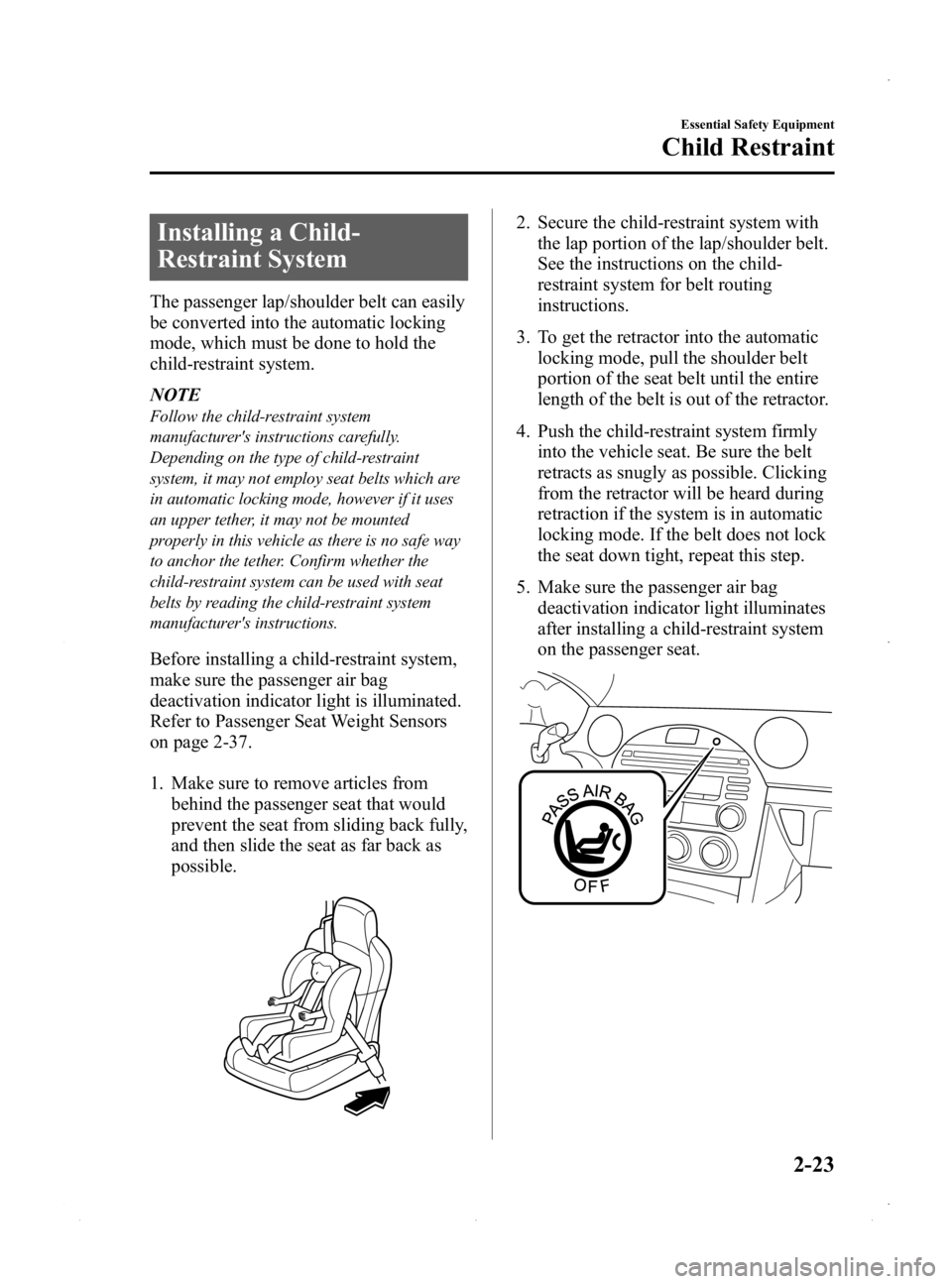
Black plate (35,1)
Installing a Child-
Restraint System
The passenger lap/shoulder belt can easily
be converted into the automatic locking
mode, which must be done to hold the
child-restraint system.
NOTE
Follow the child-restraint system
manufacturer's instructions carefully.
Depending on the type of child-restraint
system, it may not employ seat belts which are
in automatic locking mode, however if it uses
an upper tether, it may not be mounted
properly in this vehicle as there is no safe way
to anchor the tether. Confirm whether the
child-restraint system can be used with seat
belts by reading the child-restraint system
manufacturer's instructions.
Before installing a child-restraint system,
make sure the passenger air bag
deactivation indicator light is illuminated.
Refer to Passenger Seat Weight Sensors
on page 2-37.
1. Make sure to remove articles frombehind the passenger seat that would
prevent the seat from sliding back fully,
and then slide the seat as far back as
possible.
2. Secure the child-restraint system withthe lap portion of the lap/shoulder belt.
See the instructions on the child-
restraint system for belt routing
instructions.
3. To get the retractor into the automatic locking mode, pull the shoulder belt
portion of the seat belt until the entire
length of the belt is out of the retractor.
4. Push the child-restraint system firmly into the vehicle seat. Be sure the belt
retracts as snugly as possible. Clicking
from the retractor will be heard during
retraction if the system is in automatic
locking mode. If the belt does not lock
the seat down tight, repeat this step.
5. Make sure the passenger air bag deactivation indicator light illuminates
after installing a child-restraint system
on the passenger seat.
Essential Safety Equipment
Child Restraint
2-23
MX-5_8EN7-EA-14E_Edition3 Page35
Friday, September 5 2014 3:19 PM
Form No.8EN7-EA-14E
Page 36 of 448
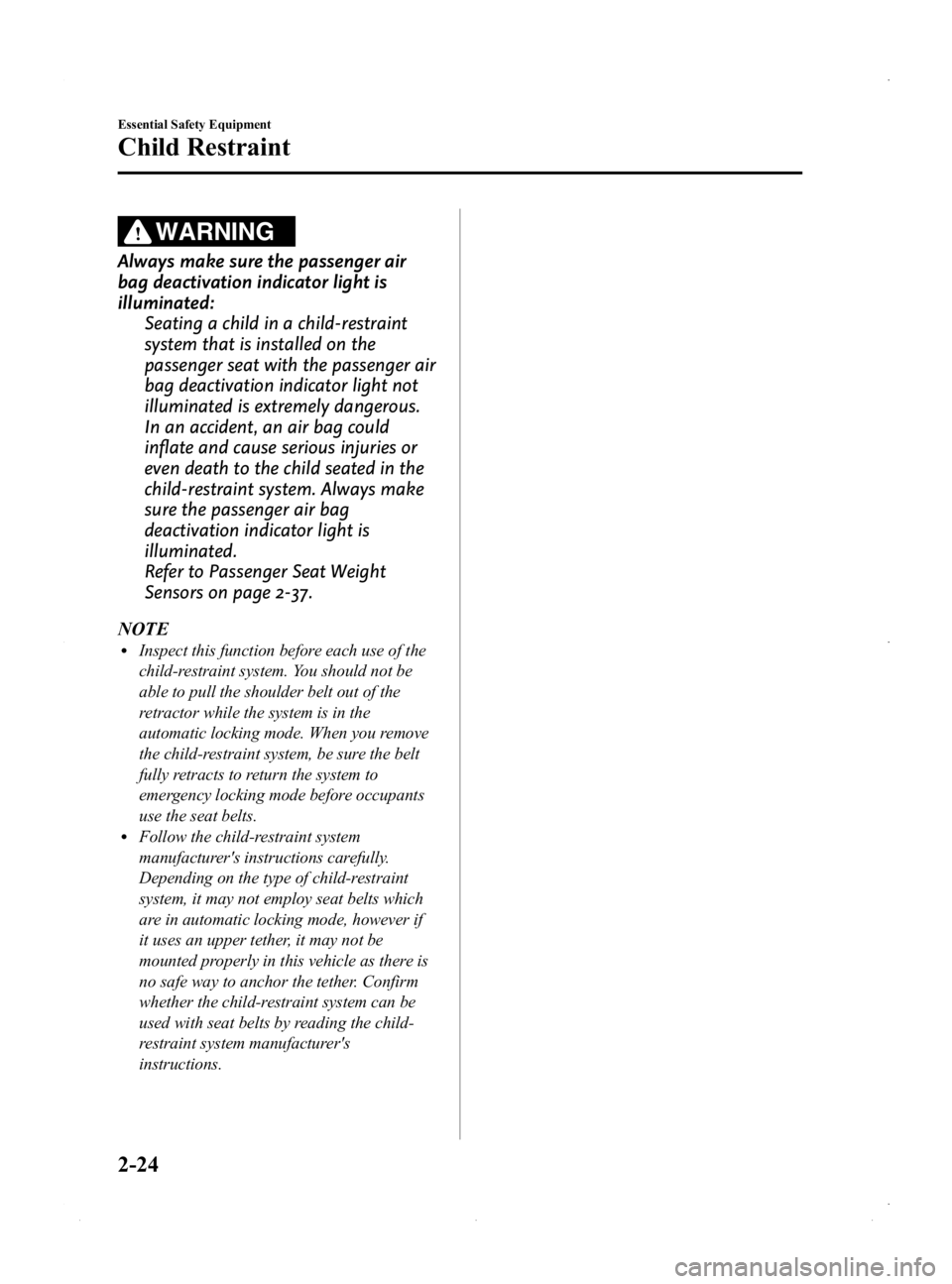
Black plate (36,1)
WARNING
Always make sure the passenger air
bag deactivation indicator light is
illuminated:Seating a child in a child-restraint
system that is installed on the
passenger seat with the passenger air
bag deactivation indicator light not
illuminated is extremely dangerous.
In an accident, an air bag could
inflate and cause serious injuries or
even death to the child seated in the
child-restraint system. Always make
sure the passenger air bag
deactivation indicator light is
illuminated.
Refer to Passenger Seat Weight
Sensors on page 2-37.
NOTE
lInspect this function before each use of the
child-restraint system. You should not be
able to pull the shoulder belt out of the
retractor while the system is in the
automatic locking mode. When you remove
the child-restraint system, be sure the belt
fully retracts to return the system to
emergency locking mode before occupants
use the seat belts.
lFollow the child-restraint system
manufacturer's instructions carefully.
Depending on the type of child-restraint
system, it may not employ seat belts which
are in automatic locking mode, however if
it uses an upper tether, it may not be
mounted properly in this vehicle as there is
no safe way to anchor the tether. Confirm
whether the child-restraint system can be
used with seat belts by reading the child-
restraint system manufacturer's
instructions.
2-24
Essential Safety Equipment
Child Restraint
MX-5_8EN7-EA-14E_Edition3 Page36
Friday, September 5 2014 3:19 PM
Form No.8EN7-EA-14E
Page 37 of 448
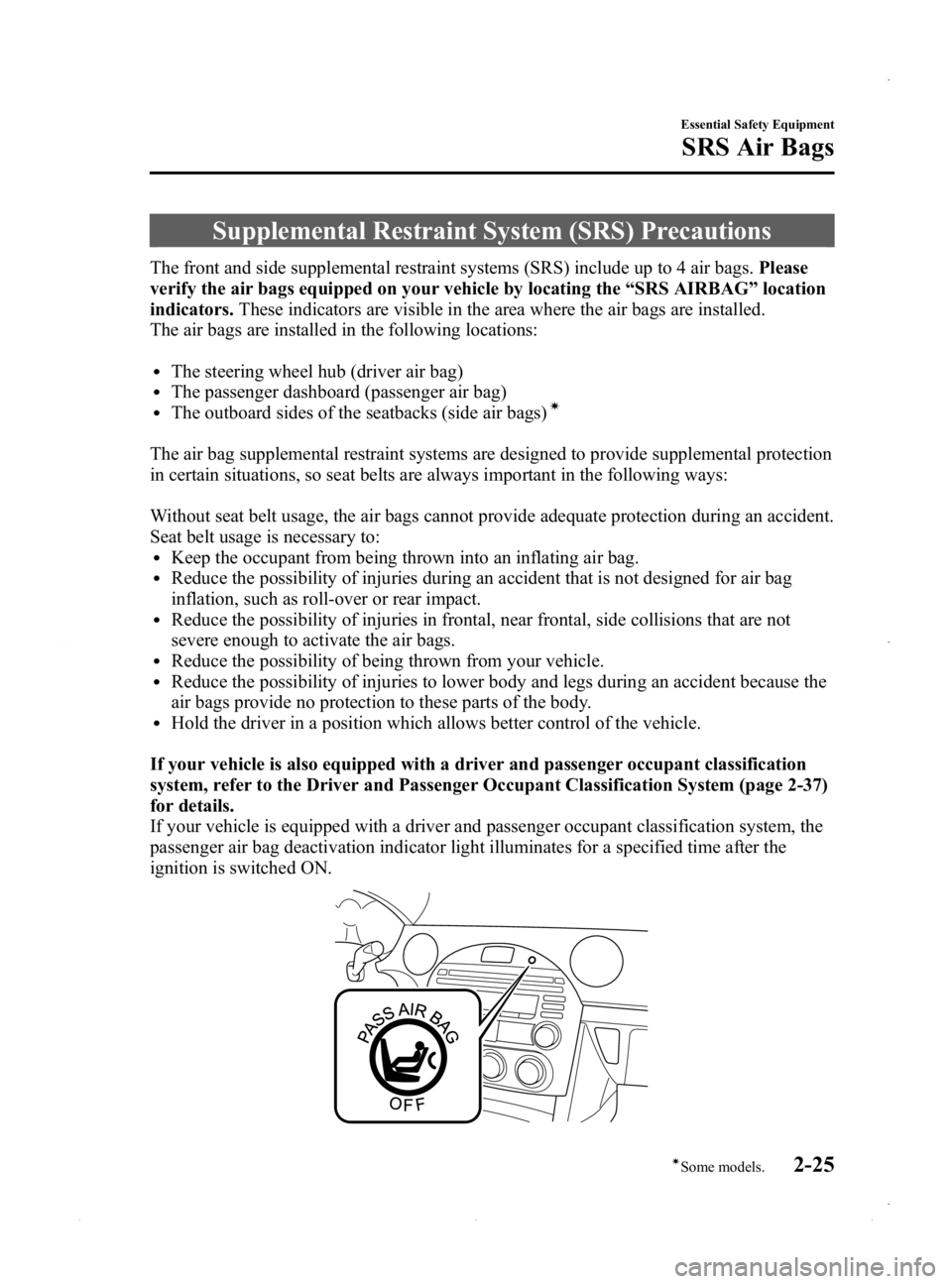
Black plate (37,1)
Supplemental Restraint System (SRS) Precautions
The front and side supplemental restraint systems (SRS) include up to 4 air bags.Please
verify the air bags equipped on your vehicle by locating the “SRS AIRBAG ”location
indicators. These indicators are visible in the area where the air bags are installed.
The air bags are installed in the following locations:
lThe steering wheel hub (driver air bag)lThe passenger dashboard (passenger air bag)lThe outboard sides of the seatbacks (side air bags)í
The air bag supplemental restraint systems are designed to provide supplemental protection
in certain situations, so seat belts are always important in the following ways:
Without seat belt usage, the air bags cannot provide adequate protection during an accident.
Seat belt usage is necessary to:
lKeep the occupant from being thrown into an inflating air bag.lReduce the possibility of injuries during an accident that is not designed for air bag
inflation, such as roll-over or rear impact.
lReduce the possibility of injuries in frontal, near frontal, side collisions that are not
severe enough to activate the air bags.
lReduce the possibility of being thrown from your vehicle.lReduce the possibility of injuries to lower body and legs during an accident because the
air bags provide no protection to these parts of the body.
lHold the driver in a position which allows better control of the vehicle.
If your vehicle is also equipped with a driver and passenger occupant classification
system, refer to the Driver and Passenger Occupant Classification System (page 2-37)
for details.
If your vehicle is equipped with a driver and passenger occupant classification system, the
passenger air bag deactivation indicator light illuminates for a specified time after the
ignition is switched ON.
Essential Safety Equipment
SRS Air Bags
2-25íSome models.
MX-5_8EN7-EA-14E_Edition3 Page37
Friday, September 5 2014 3:19 PM
Form No.8EN7-EA-14E
Page 38 of 448

Black plate (38,1)
Small children must be protected by a child-restraint system as stipulated by law in every
state and province. In certain states and provinces, larger children must use a child-restraint
system (page 2-18).
Carefully consider which child-restraint system is necessary for your child and follow the
installation directions in this Owner's Manual as well as the child-restraint system
manufacturer's instructions.
Do not use a child-restraint system which employs an upper tether because there is no
appropriate means to anchor the tether.
WARNING
Seat belts must be worn in air bag equipped vehicles:Depending only on the air bags for protection during an accident is dangerous.
Alone, air bags may not prevent serious injuries. The appropriate air bags can be
expected to inflate only in the first accident, such as frontal, near frontal, side
collisions that are at least moderate. Vehicle occupants should always wear seat
belts.
Always make sure the passenger air bag deactivation indicator light is illuminated
when using a child-restraint system: Seating a child in a child-restraint system that is installed on the passenger seat with
the passenger air bag deactivation indicator light not illuminated is extremely
dangerous. In an accident, an air bag could inflate and cause serious injuries or even
death to the child seated in the child-restraint system. Always make sure the
passenger air bag deactivation indicator light is illuminated.
Do not sit too close to the driver and passenger air bags: Sitting too close to the driver and passenger air bag modules or placing hands or
feet on them is extremely dangerous. The driver and passenger air bags inflate with
great force and speed. Serious injuries could occur if someone is too close. The driver
should always hold onto only the rim of the steering wheel. The seat passenger
should keep both feet on the floor. Seat occupants should adjust their seats as far
back as possible and always sit upright against the seatbacks with seat belts worn
properly.
Do not sit too close to a door or lean against doors in vehicles with side air bags: Sitting too close to the side air bag modules or placing hands on them is extremely
dangerous. A side air bag inflates with great force and speed directly out of the
outboard shoulder of the seat and expands along the door on the side the car is hit.
Serious injury could occur if someone is sitting too close to the door or leaning
against a window in the seats. Furthermore, sleeping up against the door or hanging
out the driver-side window while driving could block the side air bag and eliminate
the advantages of supplemental protection. Give the side air bags room to work by
sitting in the center of the seat while the vehicle is moving with seat belts worn
properly.
2-26
Essential Safety Equipment
SRS Air Bags
MX-5_8EN7-EA-14E_Edition3 Page38
Friday, September 5 2014 3:19 PM
Form No.8EN7-EA-14E
Page 39 of 448
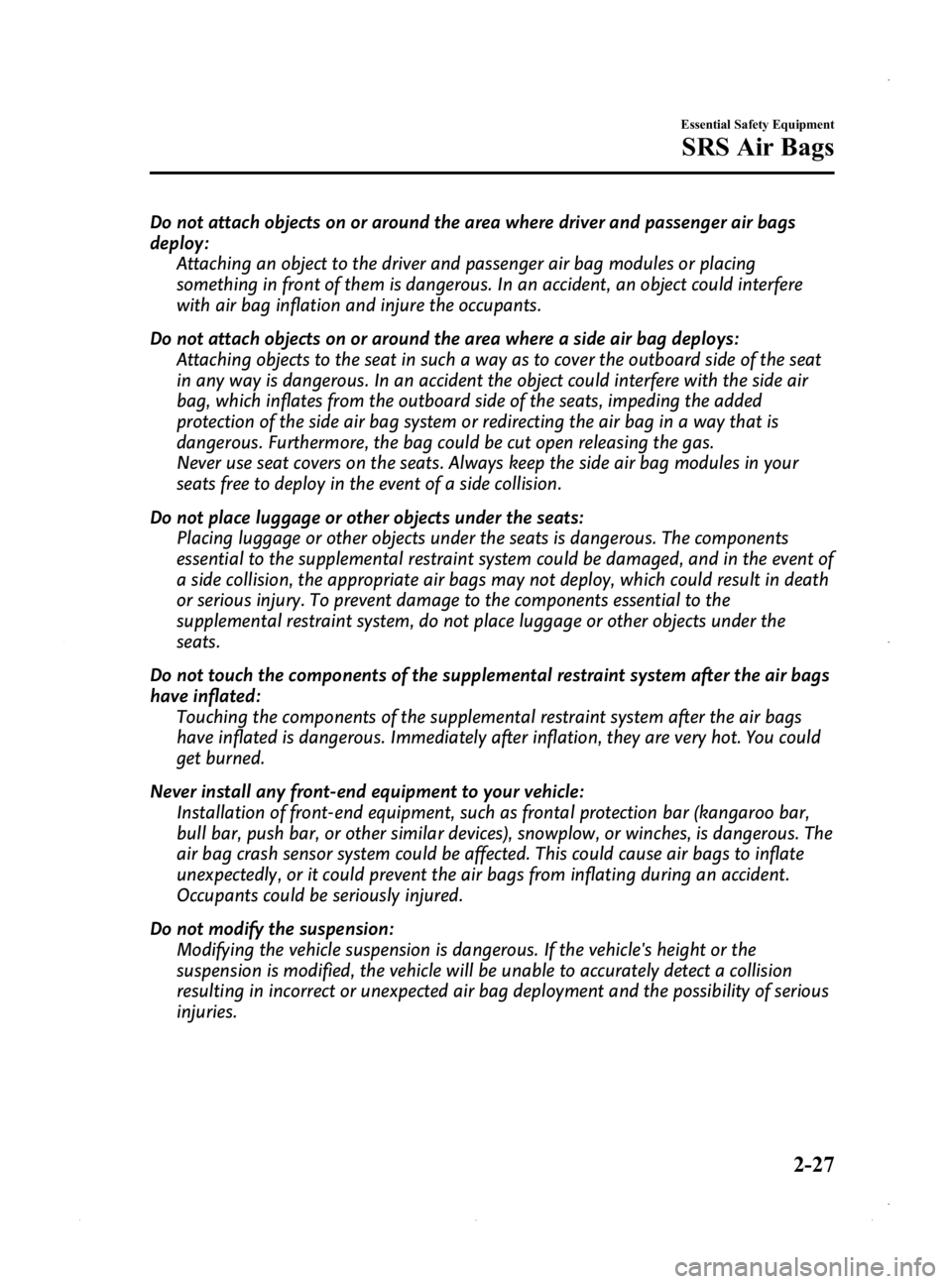
Black plate (39,1)
Do not attach objects on or around the area where driver and passenger air bags
deploy:Attaching an object to the driver and passenger air bag modules or placing
something in front of them is dangerous. In an accident, an object could interfere
with air bag inflation and injure the occupants.
Do not attach objects on or around the area where a side air bag deploys: Attaching objects to the seat in such a way as to cover the outboard side of the seat
in any way is dangerous. In an accident the object could interfere with the side air
bag, which inflates from the outboard side of the seats, impeding the added
protection of the side air bag system or redirecting the air bag in a way that is
dangerous. Furthermore, the bag could be cut open releasing the gas.
Never use seat covers on the seats. Always keep the side air bag modules in your
seats free to deploy in the event of a side collision.
Do not place luggage or other objects under the seats: Placing luggage or other objects under the seats is dangerous. The components
essential to the supplemental restraint system could be damaged, and in the event of
a side collision, the appropriate air bags may not deploy, which could result in death
or serious injury. To prevent damage to the components essential to the
supplemental restraint system, do not place luggage or other objects under the
seats.
Do not touch the components of the supplemental restraint system after the air bags
have inflated: Touching the components of the supplemental restraint system after the air bags
have inflated is dangerous. Immediately after inflation, they are very hot. You could
get burned.
Never install any front-end equipment to your vehicle: Installation of front-end equipment, such as frontal protection bar (kangaroo bar,
bull bar, push bar, or other similar devices), snowplow, or winches, is dangerous. The
air bag crash sensor system could be affected. This could cause air bags to inflate
unexpectedly, or it could prevent the air bags from inflating during an accident.
Occupants could be seriously injured.
Do not modify the suspension: Modifying the vehicle suspension is dangerous. If the vehicle's height or the
suspension is modified, the vehicle will be unable to accurately detect a collision
resulting in incorrect or unexpected air bag deployment and the possibility of serious
injuries.
Essential Safety Equipment
SRS Air Bags
2-27
MX-5_8EN7-EA-14E_Edition3 Page39
Friday, September 5 2014 3:19 PM
Form No.8EN7-EA-14E
Page 40 of 448
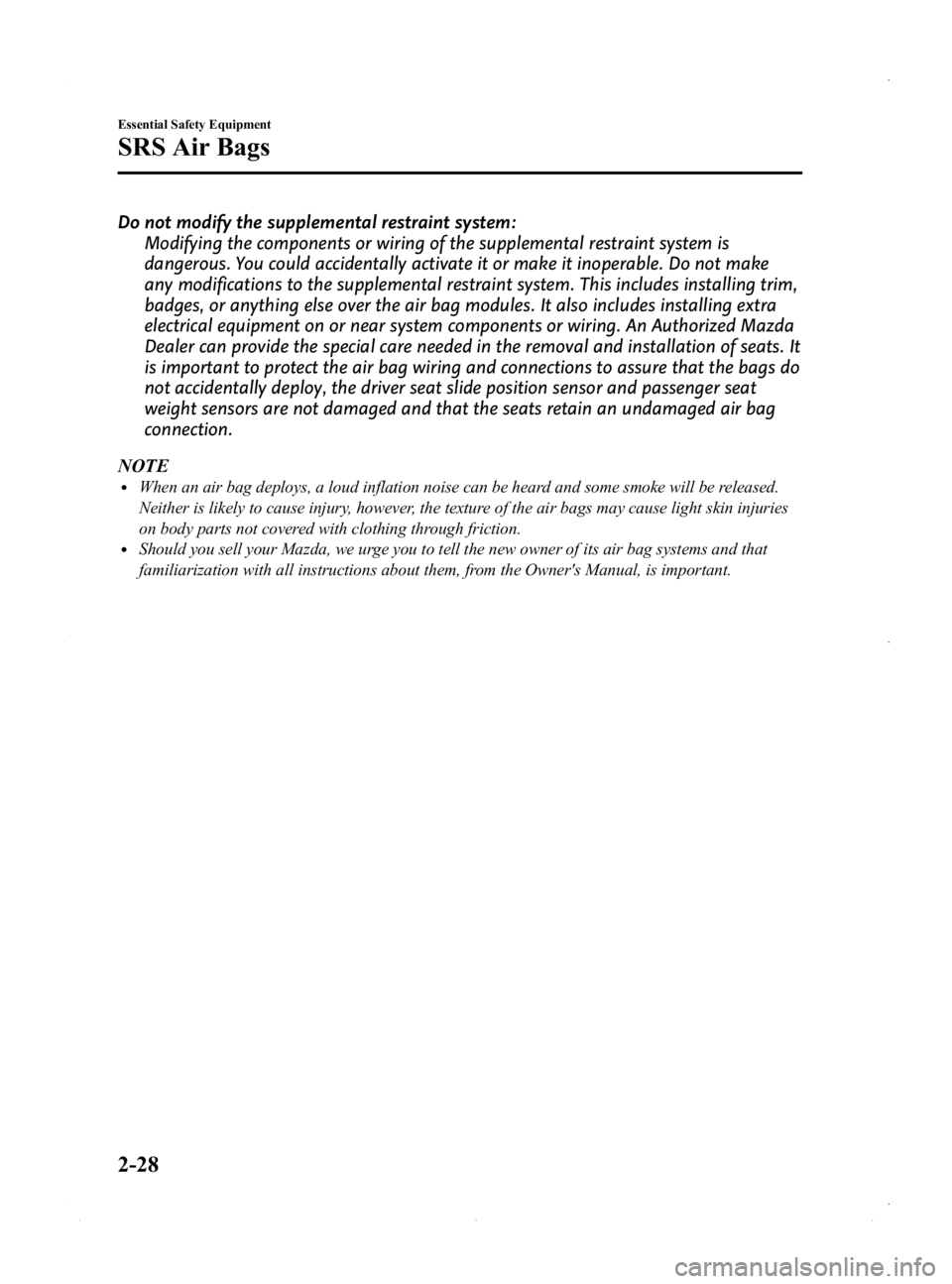
Black plate (40,1)
Do not modify the supplemental restraint system:Modifying the components or wiring of the supplemental restraint system is
dangerous. You could accidentally activate it or make it inoperable. Do not make
any modifications to the supplemental restraint system. This includes installing trim,
badges, or anything else over the air bag modules. It also includes installing extra
electrical equipment on or near system components or wiring. An Authorized Mazda
Dealer can provide the special care needed in the removal and installation of seats. It
is important to protect the air bag wiring and connections to assure that the bags do
not accidentally deploy, the driver seat slide position sensor and passenger seat
weight sensors are not damaged and that the seats retain an undamaged air bag
connection.
NOTE
lWhen an air bag deploys, a loud inflation noise can be heard and some smoke will be released.
Neither is likely to cause injury, however, the texture of the air bags may cause light skin injuries
on body parts not covered with clothing through friction.
lShould you sell your Mazda, we urge you to tell the new owner of its air bag systems and that
familiarization with all instructions about them, from the Owner's Manual, is important.
2-28
Essential Safety Equipment
SRS Air Bags
MX-5_8EN7-EA-14E_Edition3 Page40
Friday, September 5 2014 3:19 PM
Form No.8EN7-EA-14E